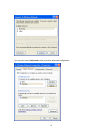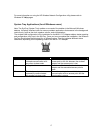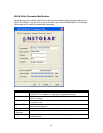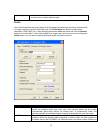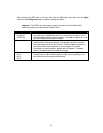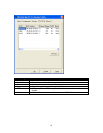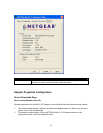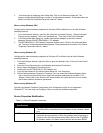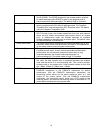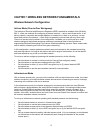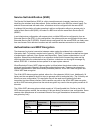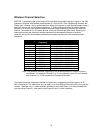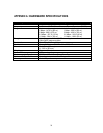
26
When in Infrastructure mode, this field defines the Extended Service
Set ID (ESSID). The ESSID assigned to the wireless node is required
to match the access point ESSID in order for the wireless node to
communicate with the access point. The default SSID is “Wireless”.
Fragment Threshold Indicates the packet length used for fragmentation. Packets larger than
the size programmed in this field will be fragmented. The Fragment
Threshold value must be larger than RTS Threshold value. The default
value for Fragment Threshold is 2432.
Network Type Configurable between 802.11 Ad-hoc and Infrastructure modes. In
802.11 Ad-hoc mode, the wireless nodes form their own local network
where the end nodes communicate peer-to-peer without an access
point. In Infrastructure mode, the wireless searches all available
wireless channels to associate with an access point. The default value
for Operating Mode is Infrastructure.
Power Save Mode The Power Save option is designed to conserve the battery life of your
computer. When Power Save is enabled, your MA311 PCI Adapter will
go into sleep mode to minimize power consumption.
Preamble Type A long transmit preamble allows the receiver to lock into the received
bit patterns more easily. A short transmit preamble provides better
performance. An auto transmit preamble is either short or long,
negotiated between the wireless node and the device it is
communicating with. The default value is Long Tx Preamble.
Transmit Rate Allows you to define the data transfer rate. The default value is Auto. In
this case, the best transfer rate is negotiated between the wireless
node and the device it is communicating with. This could be another
wireless node or an access point. Other possible values for this field
are 1 Mbps, 2 Mbps, 5.5 Mbps, and 11 Mbps.
RTS Threshold The packet size the wireless node uses to determine if it should use the
CSMA/CD mechanism or the CSMA/CA mechanism for packet
transmission. With the CSMA/CD transmission mechanism, the
transmitting station sends out the actual packet as soon as it has
waited for the silence period. With the CSMA/CA transmission
mechanism, the transmitting station sends out a RTS packet to the
receiving station, and waits for the receiving station to send back a CTS
packet before sending the actual packet data.



